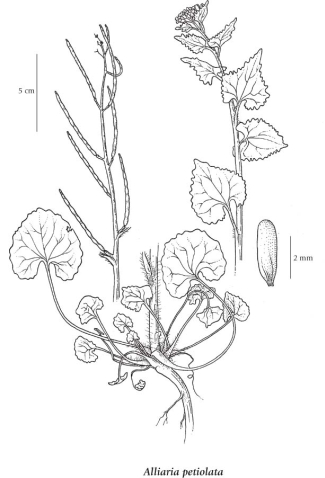garlic mustard (hedge garlic)
Brassicaceae (Mustard family)
Introduction to Vascular Plants
Introduction
Garlic mustard is a highly invasive introduced species in the mustard family (Brassicaceae) that originates from Eurasia. In North America, it is found in many US states, particularly in the eastern US, though it is absent in the southern US states from Florida to California (USDA 2011). In Canada, it is found in British Columbia, New Brunswick, Nova Scotia, Ontario and Quebec. In Ontario, it is often a dominant understorey herb in disturbed sites and can form a thick ground cover. In BC, it is reported from the Okanagan, the Lower Mainland and the Victoria area. It is a biennial tap-rooted species with an erect form and white mustard-type flowers. It is easily recognized by its dark green kidney-shaped leaves and the noticeable garlic odour of crushed leaves. It is known to inhibit ectomycorrhizal fungi where it grows, which may influence seedling establishment of native species (Wolfe et al. 2008). There is evidence that some populations of this species in North America originated from the British Isles, though it is possible that there have been multiple introductions from other locations (Meekins et al. 2001).
|
Species Information
General:
Biennial herb from a taproot; stem erect and unbranched below inflorescence, sparsely hairy below, glabrous or with whitish bloom above, 20-120 cm tall; garlic smell, especially from root but also from crushed leaves.
Leaves:
Basal leaves kidney-shaped, slender-stalked; stem leaves heart-shaped (the notch at the base) to deltoid, margins wavy or coarsely toothed, (1.5) 3-6 cm wide.
Flowers:
In simple or compound racemes, often with leafy bracts at base, 6 mm in diameter; petals white, 6 mm long, twice the length of sepals.
Fruits:
Siliques, spreading and curving upward to be almost erect, 4-6 cm long, 2 mm wide, somewhat 4-angled, on thick stalks 4-6 mm long; seeds blackish, 3 mm long.
Illustration

If more than one illustration is available for a species (e.g., separate illustrations were provided for two subspecies) then links to the separate images will be provided below. Note that individual subspecies or varietal illustrations are not always available.
Illustration Source: The Illustrated Flora of British Columbia
Habitat and Range
Mesic to dry disturbed sites and waste places in the lowland and lower montane zones; rare in SW and SC BC; introduced from Eurasia.Status Information
Synonyms
Synonyms and Alternate Names:
Alliaria alliaria (L.) Britt.
Alliaria officinalis
Erysimum alliaria L.
Sisymbrium alliaria (L.) Scop.
Taxonomic Notes
Alliaria petiolata is considered an emerging invasive species in the Vancouver region by the Greater Vancouver Invasive Plant Council (2009). An emerging invasive is defined by them as: currently found in isolated, sparse populations but are rapidly expanding their range within the region.
|
References
Meekins, J. F., H. E. Ballard, Jr., and B. C. McCarthy. 2001. Genetic Variation and Molecular Biogeography of a North American Invasive Plant Species (Alliaria petiolata, Brassicaceae). International Journal of Plant Science 162 (1): 161–169.
USDA. 2010. Alliaria petiolata. United States Department of Agriculture Plants Database. Available Online.
Wolfe, Benjamin E., Vikki L. Rodgers, Kristina A. Stinson and Anne Pringle. 2008. The invasive plant Alliaria petiolata (garlic mustard) inhibits ectomycorrhizal fungi in its introduced range. Journal of Ecology 96 (4): 777-783.